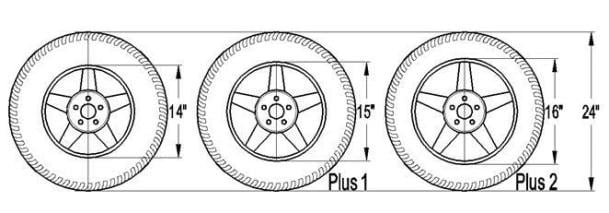
Plus Sizing is a fairly recent trend (I think it started in the late 80's or early 90's). Well when I say recent, I mean compared to the 50's and 60's when I was getting into cars and making them street cool. The basic idea of Plus Sizing is to replace the stock wheel size with a larger diameter wheel and still maintain the same original tire and wheel combination diameter. Back in the early days, up to and including the 70's, the only thing that happened when you put larger diameter tires on your rod, was the speedometer read slower than you were actually going. That only worked when you said "but Dad, the speedometer said I was only going 50".
In today's world, when you change the wheel and tire combination diameter, it effects a number of things with your ride. Not only will it change the speedo reading, but the ABS braking system, the engine management system and with some cars the suspension control system. Computers don't take kindly to changes of input components.
So to make sure you don't alter the input from the wheel and tire combination, the diameter of the OEM combination needs to be maintained. To accomplish this you need to understand the meaning of Plus Sizing. A simple definition is to take the original wheel diameter and plus up from there. A Plus 1 conversion is upping the diameter of the original size by 1 inch (i.e. 14" to 15"). In some extremes I've heard of a Plus 9 conversion (i.e. 17" to 26"). That's a bit radical for me, but to each his own. Most tire and wheel dealers are very aware of the Plus Sizing concept and can guide you as to the proper tire size to fit your wheel diameter choice and maintain the original tire and wheel combination diameter. It's pretty difficult to get the exact match, but if you are within 5% you're okay.
The Pro's - First of all, you'll be cool if you Plus Size. The bigger the diameter, the cooler you are (at least some folks think so). The biggest benefit from Plus Sizing is the increased road handling. By increasing the wheel diameter (and maintaining the original overall diameter), the height of the tire side wall deceases. This has the effect of less tire sway or roll, and increases the stability or cornering ability of your ride. Other than those 2 attributes, I'm hard pressed to come up with more Pro's.
The Con's - The first thing that comes to mind is the loss of suspension. By deceasing the side wall of the tire, you will increase the effect of road bumps, pot holes, expansion joints and all the other deformities of our roads and highways. Road noise will be increased also. In addition to the loss of ride comfort, you will also experience a loss of free time. I come to this conclusion based on the theory that the bigger the wheel, the more time it requires to keep it shining. Another Con is the tire mounting folks that have to put these tires on these wheels (20" and up) aren't real thrilled with the whole concept.
A few things to beware of when choosing to Plus Size. The larger the diameter of the wheel, the more difficult it is to meet the load requirements for a safe and reliable wheel. Some manufacturers solve the problem by adding material to the wheel so it will pass the performance standards (see TECH Stuff 3). By adding material, the weight of the wheel becomes heavier than the suspension the vehicle is designed to take and function properly. The tire and wheel are considered unsprung weight, and can cause excessive wear on the struts or shocks, bearings, spindles and brake systems.